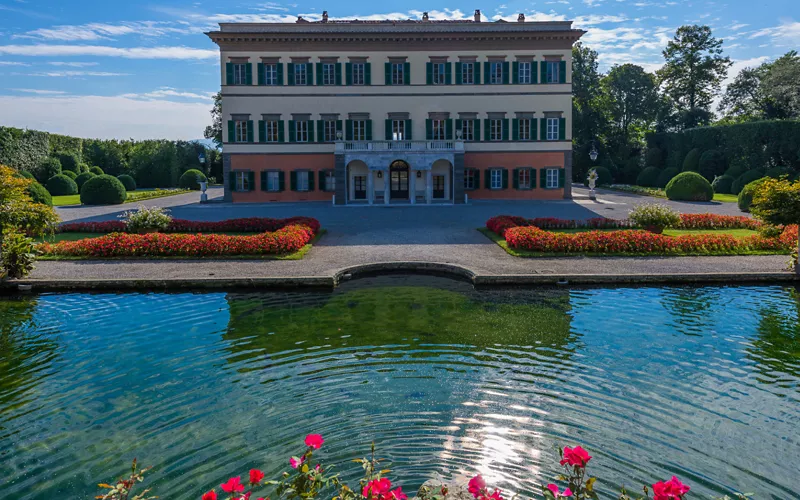This content was automatically translated. View the original text.

Overview
The gardens of Villa Reale in Marlia, an enchantment between art and nature
The park of the Villa Reale in Marlia, near Lucca, is among the most beautiful in Tuscany and Italy, an enchanting place, once exclusive to the aristocracy, for a day of art and nature, strolling through the greenery among fascinating architecture, or organising a pleasant picnic in the open air.
It covers 16 hectares. The gardens are partly of 17th-century design, on a terrace, with hedges, flower beds and tall trees, partly with "English-style" landscape, famous for its "living collection" of camellias.
Inside the Park, you will find: the luxurious Villa Reale, used as a fortress by the Duke of Tuscia, with its majestic Water Theatre; the Villa del Vescovo, built in the 16th century on the ruins of an ancient medieval castle, and the 19th-century Orthodox Chapel of San Biagio; the Palazzine Gemelle by architect Giovanni Lazzarini, at the Park’s entrance; the characteristic 18th-century Palazzina dell'Orologio with six-hour clock; and the Chapel of San Francesco Saverio.
The story of a camellia-scented "Napoleonic dream"
The history of this wonderful villa dates back to the early Middle Ages, it prospered as a stately residence during the Renaissance and was significantly transformed during the Napoleonic period.
The complex was purchased in 1806 by Napoleon's sister, Princess Elisa Bonaparte Baciocchi, who had the park enlarged and redesigned according to English-style, one of the few in Italy, enriching it with new plant species, such as the famous camellias. Testifying to the lively court life at that time is the passage of the great musician Niccolò Paganini, who presented the premiere of Racine's "Phaedra" here in the Verzura theatre.
When the Principality of Lucca became a Duchy, the villa passed to the Bourbon dynasty, and continued to be used as a summer residence. In the Italian Kingdom, it belonged to King Vittorio Emanuele II and, after some troubles, was bought by the Pecci Blunt Counts, in 1923, who restored it by adding new elements in an eclectic style, assigning the renovation of the park to an established French architect, Jacques Greber, who created streams, woods, a lake and other landscape elements that we can still appreciate today. Among the innovations presented by Greber is the Spanish Art Deco garden, distinguished by its geometric shapes, water fountains and the flowering of hibiscus, rose creepers, hypericum.
Over the past few years, the complex of the Villa Reale in Marlia has been the subject of an extensive restoration project by its current owners, allowing it to reopen to the public in 2019.
Pan's grotto
In the oldest part of the garden is Pan's grotto, a nymphaeum constructed between 1570 and 1580, dedicated to the deity of shepherds and the countryside. Its exterior is characterised by wide arches, beyond which one enters a cave-like environment decorated with masks and niches. The work is credited to Bernardo Buontalenti, the same artist who created the grotto in Florence’s Boboli Gardens.
The Gardens, with the old Verzura Theatre, the avenue of camellias, the lake, the heated pool
Built between 1666 and 1670, Verzura Theatre at the Villa Reale in Marlia is the oldest in Europe, an extraordinary testimony to the style of the time to provide gardens with natural open-air theatres carved into the vegetation. The stage is a meadow, the wings are tall yew hedges embellished with terracotta statues representing characters from the commedia dell'arte. In this place of pleasure, maestro Niccolò Paganini played his violin for Élisa Bonaparte, and plays and concerts are still held here today.
The first camellias at the Villa Reale in Marlia, considered exotic plants at the time, were brought from the Royal Palace of Caserta on the orders of Elisa Bonaparte for her brother Joseph, then on the throne of Naples. Thanks to the princess, today camellias are a characteristic feature of this magnificent place and welcome visitors as if in a "dream".
To the architect Greber, on the other hand, we owe the 1920s lake, which today is one of the most important landscape elements of the park, as well as a valuable structure for proper irrigation. In the heated Pool, very modern for its time, early 20th century AD, along with the tennis, bocce and croquet courts, many excellent guests of the Pecci Blunt family, such as the artist Salvador Dali and the writer Alberto Moravia, have spent time here.
The olfactory trail, for a sensory journey through time and the seasons
Guests at the Villa Reale in Marlia are greeted in a unique and extraordinary experience of an "immersive" connection with nature and art. Visits include a wonderful olfactory trail, providing an unmissable sensory experience of the park's exceptional botanical biodiversity.
Many different essences accompany guests on a journey through time in every season, scents of camellias, magnolias and mimosas, wisteria and hibiscus, linden, sycamore and weeping willow, to experience the emotions that Princess Elisa Bonaparte and the park's many notable guests also experienced.